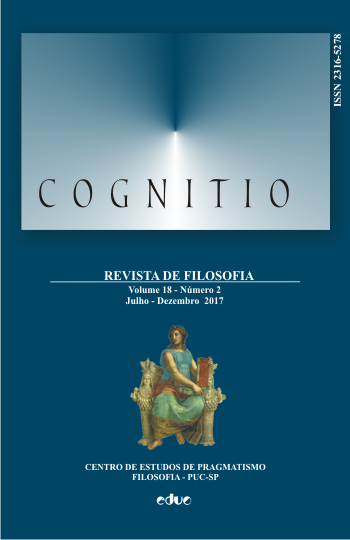The Reemergence of Schiller in Peirce’s Reminiscences of the Æsthetic Letters: A Critical Addendum to D. Dilworth’s Account of the Provenance of Peirce’s Categories in Schiller
DOI:
https://doi.org/10.23925/2316-5278.2017v18i2p326-343Keywords:
Friedrich von Schiller, Kant, Architectonic, Coenoscopy, Categories, Normative Science, Esthetics, Ethics, Logic, Normativity, Psychic Processes, HistoryAbstract
The determination of the depth and scope of the influence Schiller’s Æsthetic Letters exerted on Peirce’s philosophizing has proved a demanding interpretive task. Both the understanding of its necessity and the awareness of its difficulties have only gradually emerged in the work of generations of scholars. The aim of this paper is to sketch the present hermeneutic situation concerning the ‘Schiller-Peirce-affair’ (Section I) and to perform the subtask of interpreting a group of passages that has hitherto not received the philological attention and accuracy it deserves: Peirce’s reminiscences (1902-1913) of his juvenile study of the Letters. As these constitute our only warrant for the assumption that Schiller’s thought – besides acting as a gateway to Kant around 1855, – had any import for Peirce, the reminiscences are documented as completely as possible (Section II), in order to situate Schiller’s reemergence in Peirce’s thought in the context of the theoretical challenges Peirce is facing in view of the coenoscopic redesign of the philosophical sciences carried out between 1900 and 1903 (Section III). This architectonic contextualization of the reminiscences matches the results of our analysis of the juvenilia obtained in a twin-paper: The categoriological core of the Letters, around which Schiller builds a three-level logic of psychic processes, acted as the catalyst for Peirce’s analysis of the shortcomings of Kant’s categoriology and thus informed his conception (intension) and use (extensive application to object-realms) of the categories as purely formal – truly universal, strictly ordered, essentially modal – constituents of phenomenality, normativity and historical processuality, i.e. as the constitutive elements and architectonic dimensions of the semeiosis of an intelligence, which is capable of learning from experience.Downloads
Published
2018-02-03
How to Cite
Topa, A. (2018). The Reemergence of Schiller in Peirce’s Reminiscences of the Æsthetic Letters: A Critical Addendum to D. Dilworth’s Account of the Provenance of Peirce’s Categories in Schiller. Cognitio: Revista De Filosofia, 18(2), 326–343. https://doi.org/10.23925/2316-5278.2017v18i2p326-343
Issue
Section
Cognitio Papers









